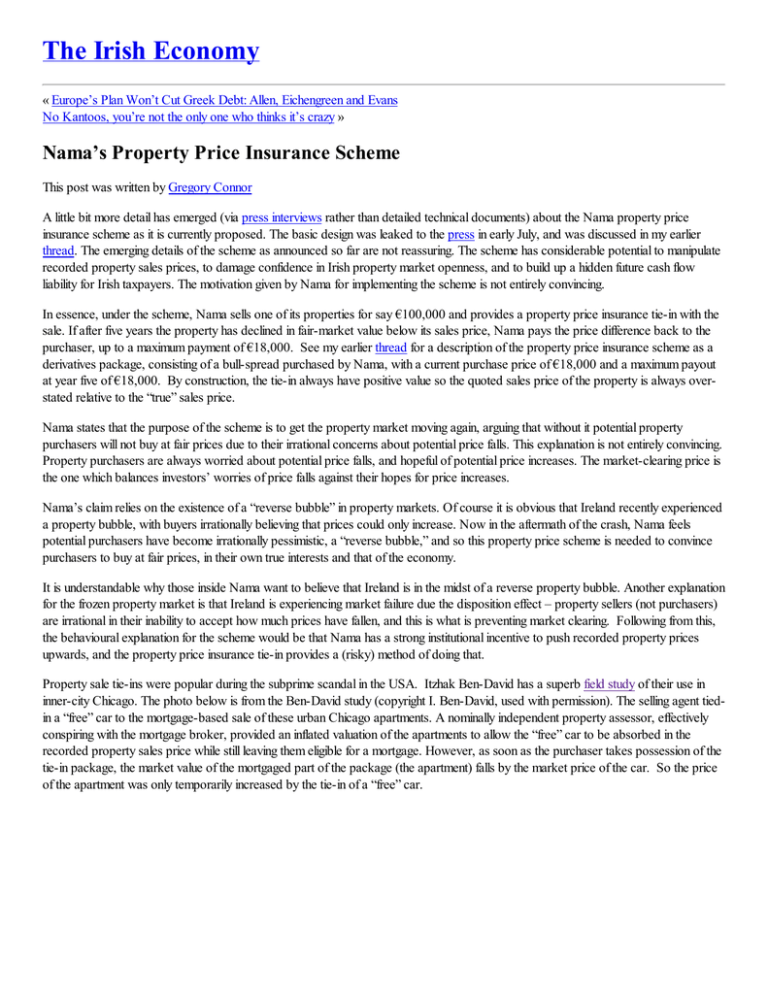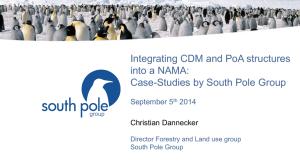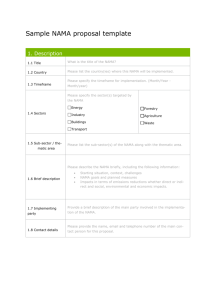The Irish Economy
advertisement

The Irish Economy « Europe’s Plan Won’t Cut Greek Debt: Allen, Eichengreen and Evans No Kantoos, you’re not the only one who thinks it’s crazy » Nama’s Property Price Insurance Scheme This post was written by Gregory Connor A little bit more detail has emerged (via press interviews rather than detailed technical documents) about the Nama property price insurance scheme as it is currently proposed. The basic design was leaked to the press in early July, and was discussed in my earlier thread. The emerging details of the scheme as announced so far are not reassuring. The scheme has considerable potential to manipulate recorded property sales prices, to damage confidence in Irish property market openness, and to build up a hidden future cash flow liability for Irish taxpayers. The motivation given by Nama for implementing the scheme is not entirely convincing. In essence, under the scheme, Nama sells one of its properties for say €100,000 and provides a property price insurance tie-in with the sale. If after five years the property has declined in fair-market value below its sales price, Nama pays the price difference back to the purchaser, up to a maximum payment of €18,000. See my earlier thread for a description of the property price insurance scheme as a derivatives package, consisting of a bull-spread purchased by Nama, with a current purchase price of €18,000 and a maximum payout at year five of €18,000. By construction, the tie-in always have positive value so the quoted sales price of the property is always overstated relative to the “true” sales price. Nama states that the purpose of the scheme is to get the property market moving again, arguing that without it potential property purchasers will not buy at fair prices due to their irrational concerns about potential price falls. This explanation is not entirely convincing. Property purchasers are always worried about potential price falls, and hopeful of potential price increases. The market-clearing price is the one which balances investors’ worries of price falls against their hopes for price increases. Nama’s claim relies on the existence of a “reverse bubble” in property markets. Of course it is obvious that Ireland recently experienced a property bubble, with buyers irrationally believing that prices could only increase. Now in the aftermath of the crash, Nama feels potential purchasers have become irrationally pessimistic, a “reverse bubble,” and so this property price scheme is needed to convince purchasers to buy at fair prices, in their own true interests and that of the economy. It is understandable why those inside Nama want to believe that Ireland is in the midst of a reverse property bubble. Another explanation for the frozen property market is that Ireland is experiencing market failure due the disposition effect – property sellers (not purchasers) are irrational in their inability to accept how much prices have fallen, and this is what is preventing market clearing. Following from this, the behavioural explanation for the scheme would be that Nama has a strong institutional incentive to push recorded property prices upwards, and the property price insurance tie-in provides a (risky) method of doing that. Property sale tie-ins were popular during the subprime scandal in the USA. Itzhak Ben-David has a superb field study of their use in inner-city Chicago. The photo below is from the Ben-David study (copyright I. Ben-David, used with permission). The selling agent tiedin a “free” car to the mortgage-based sale of these urban Chicago apartments. A nominally independent property assessor, effectively conspiring with the mortgage broker, provided an inflated valuation of the apartments to allow the “free” car to be absorbed in the recorded property sales price while still leaving them eligible for a mortgage. However, as soon as the purchaser takes possession of the tie-in package, the market value of the mortgaged part of the package (the apartment) falls by the market price of the car. So the price of the apartment was only temporarily increased by the tie-in of a “free” car. From Ben-David, Itzhak, 2011, Financial Constraints and Inflated Home Prices during the Real-Estate Boom, American Economic Journal: Applied Economics 3, 55-78. This has relevance to the Nama scheme. The purpose of scheme is to protect purchasers against property price falls. Since the property’s recorded sales price is overstated due to the tie-in, there will be an immediate effective price fall as soon as the purchaser takes possession. This means that the property price insurance scheme (as outlined) starts out with a price deficit, and must experience market price gains, rather than the absence of losses, to eliminate Nama’s future liability. This reflects a technical bug in the Nama scheme as it has been described so far. Since it does not acknowledge the market value of the price insurance that is implicitly hidden in the package sales price, it over-compensates for property price falls. It compensates not just for true price falls, but also aims to return the entire insurance premium implicitly paid by the purchaser. That needs to be fixed before the scheme is rolled out. How will Nama record the property sales price and report it to the CSO for inclusion in their national housing price index? The fairmarket value of the property insurance tie-in should be removed, otherwise the recorded transaction will distort property price information. Also, purchasers should be made aware of the two components of the package that they are purchasing and the separate valuations of each, otherwise they might be misinformed about the value of their property ex-tie-in. Both of these price distortions plagued the market in the case of property ties-in in Ben-David’s Chicago field study. The accounting for the transaction in Nama’s annual income statement is problematic. With such a long-term (five year) derivative, calibration of the implicit rental yield can have a big impact on imputed market value, so the bull spread is difficult to price accurately. If Nama underprices the tie-in insurance component of the sales package, it will over-state its current profits and understate its potential future losses. This is particularly vexing given that Nama has entered into profit-sharing incentive schemes with its developer debtors, offering them a share of any profits on completed sales. Any such profit-sharing with Nama developers should be based on conservative accounting for future hidden liabilities associated with this scheme. The scheme provides a hidden source of credit enhancement for the commercial bank funding the underlying mortgage. Property owners tend to default more often when they are in negative equity, and property price insurance substantially decreases the probability of negative equity. So the Nama scheme indirectly gives the lending bank a higher-credit-quality mortgage. Will that be reflected in the bank’s lending terms? The scheme should be structured so that buyers can purchase any given property with or without the property price insurance, with separate price quotes so that the purchaser can choose between a standard purchase or a purchase with the tie-in. This would provide clarity about the true price of the property insurance tie-in, and test Nama’s claim that the scheme adds value in the current market. With this scheme, Nama is using an Irish taxpayer provided credit-line to bet against property buyers on the five-year path of Irish property prices. At a minimum, the Irish public should be told the betting terms of the gamble being placed on its behalf. This entry was posted on Friday, August 5th, 2011 at 1:05 pm and is filed under Bailout, Banking Crisis, Prices. You can follow any responses to this entry through the RSS 2.0 feed. You can leave a response, or trackback from your own site. 3 Responses to “Nama’s Property Price Insurance Scheme” 1. Chris Says: August 5th, 2011 at 1:48 pm Nice info, The Irish public has shown itself to be in clear favor of fixing house prices. Collusion in the housing market if fine by them if it means their property is worth more for the moment. They are joined by the real estate lobby and banks from Ieland and elswhere whose balance sheets are affected by Irish property values. Together they will spend as much as the states current and future incomes as possible to increase the value of their own properties. Ireland is a 2 wolf and 1 sheep democracy. One of the few countries in the world with no land tax and has really weak legislation protecting tenants. No legislation against hoarding of development lands. No legislation against multiple buys ups of properties and property speculation. The property owing population decide to use the states income to buy up all the properties to try and artificially hold up prices NAMA. Now they are again at schemes to pump up prices artifically using everyones money. I would ask at least make this program only for 1st time buyers so at least it has some semblance of some sort of help for the sheep. Howver it seems its there for everyone, even speculators will be subsidised so that they can’t lose. Doesn’t make sense? Its not supposed to, its just suppoed to pump up peoples house values. 2. Jagdip Singh Says: August 5th, 2011 at 2:35 pm Well done Gregory for exploring the NAMA scheme. NAMA will tell you that it is still hammering out the details of the proposal, and a lengthy list of questions from me recently was met with that response. As you say there appear to be technical bugs - personally I’m lost as to how NAMA can sell one house on a street for say €200k (and stop using €100k, I’m fairly sure NAMA want to keep the concept of prices of €200k in people’s minds!) using its product and the next door neighbour is also selling their identical home. Given that the next door neighbour doesn’t have the luxury of offering the NAMA product what is the clearing price for the next-door neighbour’s? Certainly less than €200k but €160k? So NAMA’s scheme might make sales of existing property impossible at current clearing prices and rival sellers to NAMA might have to slash their prices by 20%. There is a whole can of worms there. But then again, with a credit market that has largely frozen up (2,500 transactions per quarter) and with confidence battered AND with a requirement to sell 25% of the portfolio by 2013, what is NAMA to do? So you can sympathise where it’s coming from. 3. Jesper Says: August 5th, 2011 at 2:52 pm Link to a discussion about propertyprices in Germany: http://www.toytowngermany.com/forum/index.php?showtopic=223825 It is expats discussing the pros and cons of renting vs buying in a different kind of property/rental market. Leave a Reply Name (required) Mail (will not be published) (required) Website Submit Comment The Irish Economy is proudly powered by WordPress Entries (RSS) and Comments (RSS).









